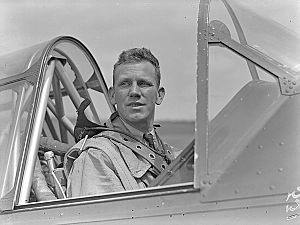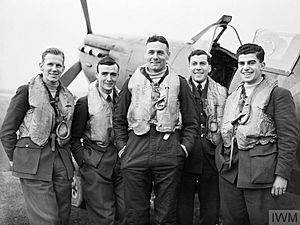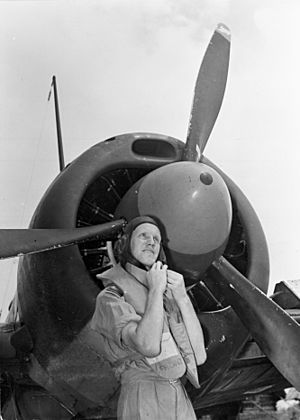John Noble MacKenzie facts for kids
Quick facts for kids
John MacKenzie
|
|
|---|---|

MacKenzie in the cockpit of a North American Harvard trainer aircraft, 1943
|
|
| Born | 11 August 1914 Goodwood, Otago, New Zealand |
| Died | 28 March 1993 (aged 78) Balclutha, New Zealand |
| Allegiance | New Zealand |
| Service/ |
Royal Air Force (1937–1944); (1946–1957) Royal New Zealand Air Force (1944–1945) |
| Rank | Squadron leader |
| Commands held | No. 64 Squadron No. 14 Squadron |
| Battles/wars | Second World War |
| Awards | Distinguished Flying Cross |
John Noble MacKenzie (born August 11, 1914 – died March 28, 1993) was a brave New Zealand flying ace during the Second World War. He flew for the Royal Air Force (RAF). A flying ace is a pilot who shoots down five or more enemy aircraft. MacKenzie was officially credited with destroying nine enemy planes.
Born in Otago, New Zealand, John MacKenzie joined the RAF in 1937. He became a pilot and flew Hawker Fury and Supermarine Spitfire planes. He helped protect soldiers during the Dunkirk evacuation. He then fought in the famous Battle of Britain, where he shot down several German aircraft. Later, he went to Singapore to help defend British Malaya from Japanese forces. After the war, he continued to serve in the RAF. He retired as a Squadron leader in 1957.
Contents
Becoming a Pilot
John Noble MacKenzie was born in Goodwood, New Zealand, on August 11, 1914. His grandfather, Thomas MacKenzie, was a former prime minister of New Zealand. John went to Timaru Boys' High School and Otago Boys' High School. After school, he worked on a farm.
In April 1937, he decided to join the Royal Air Force (RAF). His application was accepted, and he moved to the United Kingdom in October 1937. He started his flight training at RAF Desford. He learned to fly and earned his pilot's wings in June 1938. In September 1939, he joined No. 41 Squadron. This squadron flew Hawker Fury planes and later got new Supermarine Spitfires.
World War II Flying Hero
When the Second World War began, MacKenzie's squadron was still getting used to the Spitfire planes. At first, they flew patrols along the coast of England. In May 1940, they flew over the beaches of Dunkirk. This was during Operation Dynamo, when many Allied soldiers were being rescued. MacKenzie flew several missions there, but he didn't see many enemy planes.
Fighting in the Battle of Britain
In July 1940, MacKenzie's squadron joined the Battle of Britain. This was a huge air battle where the RAF defended Britain from German attacks. On July 29, MacKenzie's plane was damaged by an enemy fighter. His cockpit filled with smoke, and he had to make an emergency landing. Later that day, he attacked a German Dornier Do 17 bomber. Return fire damaged his plane again, and he had to land quickly once more.
On August 15, MacKenzie led his section against a group of German Junkers Ju 88 bombers. He probably destroyed one of them. In September, he was promoted to flying officer. On September 6, he shot down a Messerschmitt Bf 109 fighter over Canterbury. He also claimed another Bf 109 as probably destroyed that day.
Two days later, on September 9, he shot down another Bf 109. On September 11, he attacked a Heinkel He 111 bomber. Its crew had to make an emergency landing after MacKenzie damaged its engine. He also helped destroy another bomber, a Do 17, on September 15. A week later, he shot down a Bf 109 over the English Channel. He damaged another one too.
MacKenzie continued to fight bravely. He shot down a Bf 109 on October 5. He also helped shoot down a Dornier Do 215 on October 7. On October 25, he damaged two more Bf 109s. His plane ran out of fuel, and he had to land in a field, damaging his Spitfire. At the end of October, he destroyed another Bf 109.
Even after the Battle of Britain officially ended, MacKenzie's squadron still faced enemy planes. On November 17, 1940, he destroyed a Bf 109 by surprising three enemy fighters. On November 27, his squadron fought ten Bf 109s. MacKenzie shot down one that crashed near Folkestone. This was his last confirmed victory.
In November, he received the Distinguished Flying Cross (DFC). This award recognized his bravery and skill. The award citation said he had destroyed at least seven enemy aircraft since September 6, 1940. It praised his skill, courage, and determination.
In January 1941, MacKenzie was promoted to flight lieutenant. In February, King George VI presented him with his DFC at Buckingham Palace. After flying 245 missions, MacKenzie stopped offensive operations. He then took on flight control duties.
Serving in Singapore
In September 1941, MacKenzie was sent to Singapore. He joined No. 488 Squadron, a new squadron formed by the Royal New Zealand Air Force (RNZAF). This squadron needed experienced leaders like MacKenzie. He arrived in October and took command of "A" flight. The squadron flew Brewster Buffalo aircraft. MacKenzie helped train the new pilots.
When Japan attacked British Malaya in December 1941, the squadron was still training. They flew patrols to find Japanese planes. However, the Buffalo planes were not very good for fighting. In their first big battle, MacKenzie's Buffalo was damaged by a Japanese Ki-27 fighter.
The squadron lost many planes to Japanese fighters and bombing raids. By the end of the month, MacKenzie became the squadron commander. Despite getting some Hawker Hurricane planes, Japanese bombing made it hard to operate. MacKenzie even lost his hearing for a while due to the bombings. The squadron eventually moved to Australia in February 1942.
Later War Service
MacKenzie returned to New Zealand in April 1942. He took command of No. 14 Squadron of the RNZAF. He had been promoted to acting squadron leader. This squadron was made up of pilots who had served in Singapore. They flew P-40 Kittyhawk planes.
After four months, MacKenzie moved to a training unit. He stayed there until mid-1943, then returned to the United Kingdom. He completed a course at the Central Gunnery School. He then commanded a gunnery and bombing squadron.
In April 1944, MacKenzie became commander of No. 64 Squadron. This squadron flew Spitfires. They escorted bombers, attacked ships, and flew patrols. In September, he returned to New Zealand. He had transferred to the RNZAF earlier that year. He hoped to fight against the Japanese, but it didn't happen. He trained on the F4U Corsair plane. He then worked at the Fighter Leaders School until August 1945, when he left the RNZAF.
John MacKenzie was officially credited with destroying nine enemy aircraft. He also shared in the destruction of another plane. He probably destroyed three more and damaged three others.
After the War
In 1946, John MacKenzie returned to the United Kingdom and rejoined the RAF. He became commander of the Air Fighting Development Squadron. In 1948, his rank of squadron leader became permanent. He worked at the Air Ministry for two years.
Due to medical reasons, he could not fly after July 1950. He worked at the School of Land/Air Warfare and then in Hong Kong. He also served at the headquarters of the Far East Air Force in Singapore. His last job was in the United Kingdom, working on research staff. He left the RAF in October 1957.
MacKenzie returned to New Zealand and bought a car dealership in Balclutha. He ran this business until 1972, when he retired. He passed away in Balclutha on March 28, 1993. He was survived by his wife and two children.



